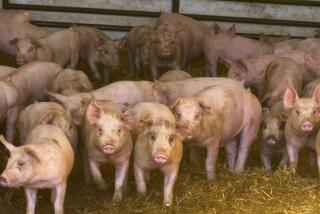The boar war that was averted on San Juan Island
- Share via
Reporting from Friday Harbor, Wash. — The history books don’t say whether the dead pig had a name. There’s also no mention of whether the slaughtered swine ended up as ham on someone’s dinner table. But one thing is clear: The porker’s plight nearly led to human bloodshed.
From his home on San Juan Island -- about 30 miles off the Washington mainland -- Lyman Cutler spotted the pig rooting through his potato patch, grabbed his musket and fired the fatal round.
After the killing, on June 15, 1859, Cutler told neighbors he’d had enough, that this wasn’t the first time he’d caught the beast munching on his spuds. In those days, the U.S. and Britain both claimed the island, which made for an uneasy truce among residents. And Cutler, an American, had shot an Englishman’s pig.
If you go
The National Historical Park, devoted to sharing the story of the Pig War, is on San Juan Island, one of the more than 70 islands in a chain bearing the same name. In the “rain shadow” of the Olympic Mountains, the San Juans get only half as much rain as Seattle and have an average of 247 sunny days a year. The summer months are the most popular for tourists, though Washington state ferries ( www.wsdot.wa.gov/ferries) take passengers and their vehicles on scenic voyages to the islands year-round.
The sesquicentennial of the Pig War means a season full of special events. The summer’s highlight will be Encampment 2009 on July 25 and 26. Besides interacting with volunteers in 1850s-era dress, visitors will be able to view two tall ships -- the Hawaiian Chieftain and the Lady Washington -- at anchor in Garrison Bay. A complete list of activities can be found on the park’s website ( www.nps.gov/sajh).
TO LEARN MORE
The San Juan Islands Visitors Bureau, www.visitsanjuans.com.
The squabbling over boundaries had been going on for years. In one earlier incident, after some Brits refused to pay taxes imposed by the Yanks, an enraged sheriff sailed to the island and, as payment, seized 39 English sheep during a nighttime raid. Lyman Cutler’s shooting of the pig proved the last straw.
It was war.
Royal Marines sailed to the island and built a camp. So too did hundreds of U.S. Army soldiers. Both sides were waiting for someone to fire the first shot, but it never came. Over a period of 13 years, through negotiation, the conflict was resolved peacefully. Now, 150 years later, English Camp and American Camp have been restored as key parts of the San Juan Island National Historical Park, where celebrations this summer will mark the sesquicentennial of a most unusual war.
“Both nations were on the brink, militarily,” says Mike Vouri, a National Park Service historian who has written extensively about what’s called the Pig War. “The crisis mushroomed much larger than anything that had gone before.”
By 1859, Vouri says, the two countries -- which had fought each other during the American Revolution and the War of 1812 -- had become trading partners. Having repealed laws against purchasing U.S. crops, England was buying American produce. In turn, the U.S. had lowered the tariffs on British manufactured goods.
“The economic engine between the two nations was very hot,” Vouri says. “It was totally contrary to the interests of both nations to go to war over an island that was 54 square miles. . . . And so the two nations, viewing this pragmatically, decided they would talk this out.”
Those talks led to the drawing of the international boundary between the U.S. and what is now Canada. The Stars and Stripes flies over the San Juan chain of islands; the maple leaf is flown on the neighboring Gulf Islands. Victoria, the capital of British Columbia, is farther south than Friday Harbor, the largest town on the San Juans.
On summer weekends, islanders in period clothing greet visitors to the National Historical Park. Part-time ranger Ron Garner is often outfitted as a blacksmith, demonstrating the craft on an iron forge. But it’s the old guns -- the rifles that fired small musket balls -- that many visitors are most eager to see, Garner says.
“Then you can make the really important point, that they were never fired at each other in anger,” he says.
Each July for more than 20 years, Garner, a retired schoolteacher, has been in charge of Encampment, the event during which scores of people from the U.S. and Canada don costumes to reenact island life during the Pig War. Playing the role of an artillery sergeant, Garner is ever-mindful of his primary message.
“The way things worked out -- using arbitration to settle difficulty -- was much, much better than the other option,” he says. “Cooler heads prevailed instead of having a shooting war.”
That theme is also central to the park’s mission.
“That’s why we exist as a park [to show] that individuals and nations can resolve their problems peacefully without resorting to violence,” notes Vouri, the historian.
“It’s not going to happen in every instance. But we have to look for new ways to resolve conflict.”
travel@latimes.com
More to Read
Sign up for The Wild
We’ll help you find the best places to hike, bike and run, as well as the perfect silent spots for meditation and yoga.
You may occasionally receive promotional content from the Los Angeles Times.






